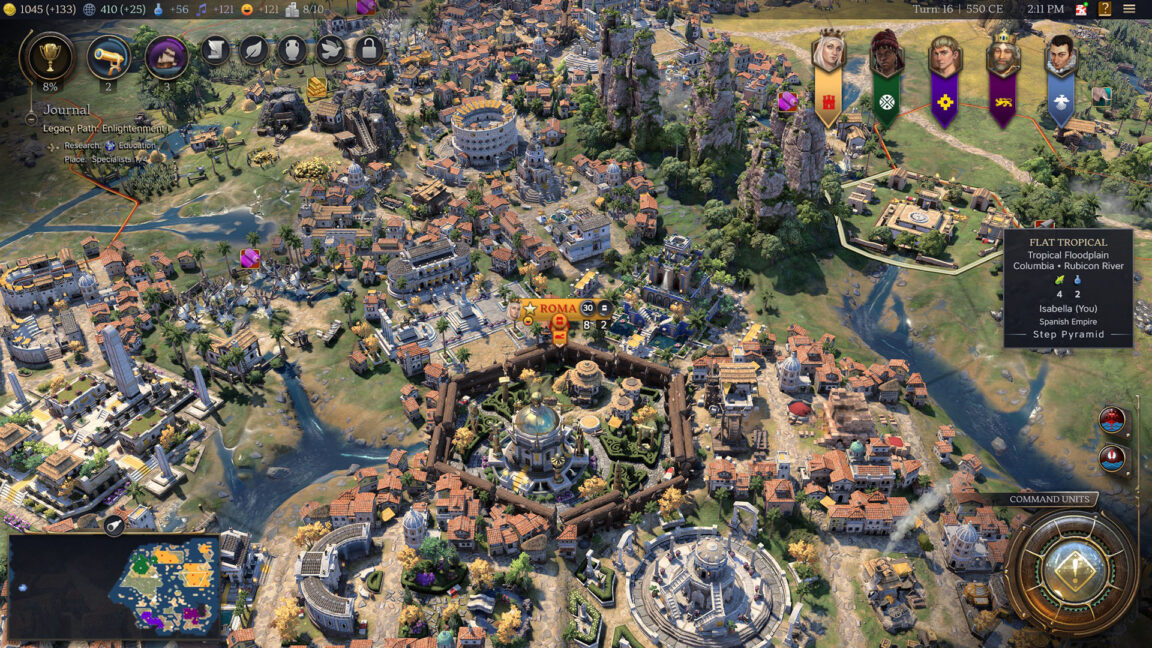Civilization VII review: A major overhaul solves Civs oldest problems
One more turn Civilization VII review: A major overhaul solves Civs oldest problems Not all changes will be popular, but it's a great launching point for a new age. Samuel Axon Feb 3, 2025 9:00 am | 3 One of the sprawling cities of Civilization VII. Credit: Samuel Axon One of the sprawling cities of Civilization VII. Credit: Samuel Axon Story textSizeSmallStandardLargeWidth *StandardWideLinksStandardOrange* Subscribers only Learn moreTheres a lot of talk of cozy games these days, and Civilization is definitely my personal cozy game. Its relaxing to get lost in a flow state, making a series of interesting decisions for one more turn, then another, late into the evening.Change is almost definitionally not cozy, though, and Civilization VII changes quite a lot especially about the games overall structure.Frankly, Ive long felt the series peaked with Civilization IV, at least for me. But after playing VII for a couple of dozen hours, theres a chance its at least as good as Civilization V, and it has the potential to even match IV with just a little more refinement.In this review, well explore all the major changes, assess whether they are worth any trade-offs, and talk about why VII has the potential to be the best Civ game in recent memory.Table of ContentsJump to sectionA specific kind of Civ playerCivilization is a franchise that caters to a broad range of players, and different people want different things from the games. It makes sense to clarify what kind of Civilization player I am so you know where Im coming from and what kind of filter to run my take through.Ive played at least a few games of Civilization a year since Civilization II came out. All told, I probably have a cumulative 2,000 hours in the franchise. I skipped Civilization III, and I played the most in the Civilization IV era, when I played weekly hotseat games with my friends in college. I frequently played the 1,000 AD scenario solo. I continued to play Civilization V, but a little less than IV. When Civilization VI came out, I wasnt as big a fan. Ive played maybe two full games a year after an initial 50 or so hours when it first arrived.Ive usually played on low to mid difficulty levels and have enjoyed the inevitable march to victory. I did work my way up through the difficulty levels in V while Steam achievement-hunting, but I didnt enjoy it as much as taking a relaxed approach.Ive spent comparatively little time playing other 4X games. I had a couple of weeks where I got really into Endless Legend, but it didnt stick long-term. I played a lot of Master of Orion II back in the day, but Ive only played a couple dozen hours of Stellaris. I did, however, obsessively play Alpha Centauri. I also love The Battle of Polytopia.If VI was your favorite Civ game, if you always play on Deity, or if youre a hardcore player who plays 5,000 hours a year, just know that Im coming at this from a different place than you are. I hope you can still filter through that and find the information you need here, though.This review is based on two full-length playthroughs of all three ages of Civilization VII, plus a little extra dabblinga total of about 35 hours. I mostly played on a Windows PC, but I also tested the game briefly on a Steam Deck. The Mac, Linux, and console versions were not made available to me.Lets dig in.The ages of civilizationCivilization VII overhauls the structure of a Civilization game more radically than weve ever seen. Whereas previous games had eras (Ancient, Classical, Medieval, Renaissance, Industrial, Modern, Atomic, Information, and Future in VI) that acted as a soft structure for how the game progressed, VII cuts everything down to just three and names them agesAntiquity, Exploration, and Modern.(This is not to be confused with the boom/bust system of the dark and golden ages in VI.) As in earlier titles, exploring with scouts plays a big role in the first age. Credit: Samuel Axon But unlike the eras of yore, VIIs ages are presented and play almost as distinct games. Ages do not just mark the passage of time; transitioning from one to another involves significant changes to the map and objectives in the game, with a summary screen displayed during each transition.Each age has its own tech and culture trees, buildings and units, and even unique victory conditions and game systems. For example, the system of spreading religions around the globe with missionaries and tracking the religious makeup of cities is exclusive to Exploration, even though there are some more basic applications of religion in Antiquity.Legacy pathsEach age has its own legacy paths corresponding to the different victory types: economic, military, science, and culture. These paths include a sequence of objectives that must be fulfilled to gain points that are tallied at the end of the age to determine rankings and decide which options you have for bonuses to start with if you continue to the next age.For example, the science legacy path in Exploration involves using specialists (urban population who build up the yields of tiles that have already been developed) to optimize city districts with very high yields, whereas the path in Modern involves using city production to build major flight and spaceflight projects.All players transition from one age to another at once when enough progress has accumulated (either in just one path or all of them). The final legacy path, for Modern, is the path to the games ultimate win conditions. Legacy paths map to victory conditions and give you a linear series of objectives with which you can gain points that assist you in starting the next age with an advantage. Samuel Axon Legacy paths map to victory conditions and give you a linear series of objectives with which you can gain points that assist you in starting the next age with an advantage. Samuel Axon You can check how far the various leaders are along each legacy path. Samuel Axon You can check how far the various leaders are along each legacy path. Samuel Axon During the age transition, you can see what bonuses your actions in the previous age will offer you in the upcoming one. Samuel Axon During the age transition, you can see what bonuses your actions in the previous age will offer you in the upcoming one. Samuel Axon You can check how far the various leaders are along each legacy path. Samuel Axon During the age transition, you can see what bonuses your actions in the previous age will offer you in the upcoming one. Samuel Axon Legacy points from the previous age can be applied to bonuses as soon as the new age starts. Samuel Axon Each age has its own civic and tech trees, and there are unique civic trees for each civilization, too. Samuel Axon As an age nears its end, a crisis can happen that affects everyone. In one example, the plague begins to spread around the world toward the end of Exploration. Each crisis has some unique gameplay elements, including crisis cards, which force you to pick between some negative effects for your civilization to face as you tackle the problem.After an age is complete, the crisis ends, a recap screen is shown, and you get to spend legacy points (which you accumulated by following the legacy paths) to gain bonuses or choose specializations for your civilization that apply when you start the next age.You also pick a new civilization for the next age, which brings us to the other major overhaul to the games formula.Leaders and civilizationsAs in all prior titles, you select a leader to play as when you start a new game, and that leader has unique bonuses or mechanics that affect how you would optimally play the game.But whereas leaders were tied to specific civilizations before, now theyre not. You can play as Benjamin Franklin, King of Persia. Those concerned with historical accuracy wont love this change, though the developer clearly designed the leaders to have some mechanical synergy with historically appropriate civilizations; these pairings are even given special labeling in the civilization-selection screen.When an age transition happens, though, you have to pick a completely new civilizationbut not just any. Several factors contribute to the list of options. The civilization you picked and which things you accomplished in the previous age make up the bulk of those factors. Again, the game nudges you toward civs that make loose sense historically (I went from Isabella leading Rome in Antiquity to Isabella leading Spain in Exploration), but its possible in some cases to do something different. You pick your leader first, and then "historical" civilization choices for each leader are labeled with a special icon. Samuel Axon You pick your leader first, and then "historical" civilization choices for each leader are labeled with a special icon. Samuel Axon This is the screen for picking a civilization when the age switch happens. As you can see, some are locked while others are available. Samuel Axon This is the screen for picking a civilization when the age switch happens. As you can see, some are locked while others are available. Samuel Axon You pick your leader first, and then "historical" civilization choices for each leader are labeled with a special icon. Samuel Axon This is the screen for picking a civilization when the age switch happens. As you can see, some are locked while others are available. Samuel Axon This fits a general theme in Civilization VII of modeling the way cultures and cities in our own world are built in layers. For example, London was a Roman city before the Anglo-Saxons and Vikings built their own settlements on top of it.To that point, you can "overbuild" buildings relevant in later ages to replace ones that were specific to an earlier age, which not-so-coincidentally helps solve the problem from VI of having to work around legacy decisions when working on optimizing your districts.Does it work, and is it still Civ?This controversial change to civilizations allows the games designers to better fine-tune civilizations bonuses, units, and buildings. Since they can be age-specific, they can tie deeply into mechanics that are endemic to a specific age. It also addresses the franchises long-standing balance problem of certain civilizations having an advantage in one part of a games trajectory but being weak in another.Likewise, putting strong guardrails around each of the three ages allows the designers to better refine and balance certain gameplay systems to interact with each other better. Its much easier to design a system that only has to be fun in a certain context than it is to produce one that needs to stay relevant and interesting throughout every phase of the game.It also acts as a catch-up or rubber-banding device. Civilization has long been criticized for the tendency of its games to snowball early. Establishing a lead in the first few eras could sometimes all but guarantee the final outcome, making the back half of the game seem like a pointless exercise to some.Since the age transitions in VII put all civs on relatively equal footing with regard to tech trees and so on, thats less of a problem. Of course, there are still the era points to spend to make your successes or failures earlier on more meaningfulthey're just not as game-defining.There are some downsides besides pedantry about historical accuracy, too. Most notably, the last 15 or so turns of an age can be a bit of a bummer.Thats because buildings and units late in an ages tech or culture trees end up being mostly irrelevant as a result of the hard reset that happens so soon after you acquire them. I also found myself incentivized to slow my civilizations progress to delay age transitions to get things optimally set up for the start of the next one, which feels unnatural and unintended.RIP busyworkAmid a number of changes to the civilization formula, another one stands out: workers (called builders in VI) are no more. Instead of directing a unit to build improvements, you do so directly from the city view each time the city grows.On one hand, this is a simplification at a time when a lot of people want their grand strategy games to get deeper and more complex. But I feel that its a good change. Workers always became unwieldy as the scale of your empire grew, and many players just ended up automating them by the later eras.The change also allows building rural improvements to integrate more neatly with the urban district system introduced in VI and refined here. Worker units have been replaced by a centralized city management screen. Samuel Axon Worker units have been replaced by a centralized city management screen. Samuel Axon As seen in the bottom right, a number of military units have been grouped in with this commander. Samuel Axon As seen in the bottom right, a number of military units have been grouped in with this commander. Samuel Axon You can level up commanders, and there are multiple talent trees for each, emphasizing different uses. Samuel Axon You can level up commanders, and there are multiple talent trees for each, emphasizing different uses. Samuel Axon As seen in the bottom right, a number of military units have been grouped in with this commander. Samuel Axon You can level up commanders, and there are multiple talent trees for each, emphasizing different uses. Samuel Axon There are other refinements that reduce unit-based busywork, too. One of the reasons IV is my favorite game in the series is that its the last one with stacks of death, where youd pile multiple military units onto one tile and move them as a group.When stacks of death were replaced by a one-unit-of-each-type-per-hex approach in V, I felt it made moving armies in the late game an infuriatingly tedious process that wasnt worth the added tactical complexity.Firaxis has struck an ideal middle ground in VII. You can now pack up to five units into a single-hex-occupying group with a military commander unit. You then just have to move that one unit to the front line before deploying everyone and commanding them individually in battle.Its a great change! (Rivers are also fully navigable by naval units, by the wayanother change that makes getting around a lot easier.)Small town, big cityI mentioned that you now manage hex improvements via the city view. There are some other changes to cities to cover. First off, newly founded settlements start as towns, not cities. Towns cant produce buildings or units normally, but you can purchase a subset of options with gold.They grow by similar rules to cities, and they have multiple specialization options that customize how they benefit your wider civilization. You can spend gold to convert them to cities, and it costs less gold to do so the more they grow. There are pros and cons to each classification, and youll almost always end up going with a balance, regardless of the age.Theres a settlement limit that is affected by ages, cultures, and technologies. Capturing or founding towns or cities beyond that limit comes with big penalties and is almost never worth it. City tiles sprawl out across the map. In this case, we have a Los Angeles-like situation where a sort of megalopolis has formed out of several cities growing into each other. Samuel Axon City tiles sprawl out across the map. In this case, we have a Los Angeles-like situation where a sort of megalopolis has formed out of several cities growing into each other. Samuel Axon Towns have specializations that change the role they have in your civilization. Samuel Axon Towns have specializations that change the role they have in your civilization. Samuel Axon There's a centralized resource assignment panel for distributing resources (and their bonuses) across all your settlements of all types Samuel Axon There's a centralized resource assignment panel for distributing resources (and their bonuses) across all your settlements of all types Samuel Axon Towns have specializations that change the role they have in your civilization. Samuel Axon There's a centralized resource assignment panel for distributing resources (and their bonuses) across all your settlements of all types Samuel Axon All told, I liked these systems. Theyre big changes, but they feel natural. I wouldnt tweak much about them.This towns classification is also relevant to what used to be known as city-states. Barbarians and city-states have merged into one concept, called independents. These are single-settlement AI civs that are either hostile or friendly. I really enjoyed this system, as it allowed me to gradually befriend independents, convert them into towns I control through diplomacy, and ultimately upgrade them to cities within my civilization. Its a satisfying progression.You court independent settlements by spending a new yield called influence, which is the foundation of a significant overhaul of how diplomacy and espionage work in the game.How to win friends and influence peopleI hated the way diplomacy and war weariness worked in VI, especially at launch. I felt that the AI was hyper-focused on baiting me into wars, and if I ever responded in kind, it was too difficult to avoid all the AI leaders turning on me because they didnt like what I was doing. Often, I would just ignore diplomacy and end up at war with almost everyone rather than engage with the systems the game had in place for managing all that.VIIs approach is much more straightforward. As noted, theres a new yield called influence, and it sits alongside gold, science, and so on. Its produced passively by certain buildings and the like. It has multiple uses, but all of them relate to affecting your relationships with other powers on the map.You can use it to build favor with independent cities, levy their troops, or ultimately bring them into your civilization. You can use it to offer trade deals to or denounce other rulers. Its also the resource used for espionage, like stealing technologies or sabotaging space race production.Thats not where it stops, though. When other leaders offer you a deal of some kind, youre given the option to spend a small amount of influence to prevent the deal from happening, no influence to accept the deal on terms that are slightly more beneficial for them, or a larger amount of influence to shift the terms of the deal to be significantly better for both of you. You can spend influence on everything from treaties to espionage. Samuel Axon You can spend influence on everything from treaties to espionage. Samuel Axon Influence is used to build favor with, leverage, and ultimate acquire independent settlements. Samuel Axon Influence is used to build favor with, leverage, and ultimate acquire independent settlements. Samuel Axon You can spend influence on everything from treaties to espionage. Samuel Axon Influence is used to build favor with, leverage, and ultimate acquire independent settlements. Samuel Axon Most critically, it plays a role in a system of war support. When a war occurs between two civilizations, every leader in the game (not just those two) can spend influence to support one side or another. The side with the most support suffers significantly less war weariness and fewer diplomatic consequences for the continuation of the war.If you have high influence yields and pour it all into supporting a war thats important to you strategically, you can put yourself in a much better position.It works extremely well, and it simplifies a lot of disparate systems that have been tried in Civ over the years into one coherent thing thats much easier to understand and manage than ever before.Of all the major additions in Civilization VII, this is my favorite. For the first time, I find diplomacy fun instead of a chore.Grab bag: Steam Deck, minor gripes, and hopes for the futureThose are the big categories of changes in VII, but there are a few things of note that dont neatly fit into any of these buckets, so lets rapid-fire through a few.Steam Deck, consoles, and controller supportConsoles have always been a footnote in the Civilization franchises storied history. There was Civilization Revolution, a stripped-down version of the game that came out on Xbox 360 and PlayStation 3. (It was better than youd think if you approached it on its own terms, but it wasnt the desktop PC Civ experience by any stretch.)Civilization VI got ports for Xbox One, PlayStation 4, and Switch, but the ports were not very good at all. The game was playable, but the ports were definitely an afterthought.So its interesting that Civilization VII will have PlayStation 4, PlayStation 5, Xbox One, Xbox Series X|S, and Nintendo Switch versions launching the same day as the PC, Mac, and Linux ones. Along with that, the game is Steam Deck Verifiedwhich wasnt even a concept when the last Civ game came out.I wasnt given access to the console versions during this review period, but I was able to try it out on Steam Deck, which gave me a sense of how it plays with a controller interface.The left stick moves between tiles to select, while the right stick moves the camera and changes the zone the left stick effects. You tap A to select something and B to back out, while the left and right triggers can be used to zoom in and out. Pressing the right bumper brings up a radial menu that gives you access to everything from the tech tree to different leaders with whom you can engage in diplomacy. The remaining buttons are direct shortcuts to commonly used features, like mini-map options (yields and so on).Civilization VII running on the Steam Deck. Credit: Samuel Axon It works pretty well! Its not as natural as using a mouse, of course, but its a big improvement on the mess that the console versions of VI presented you.The game seemed to perform OK most of the time on low settings and the native 1280800 resolution on the Steam Deck, but the exception was zooming in on large, sprawling cities in the late game. I saw some stutters and framerate chugging in that situation. Thats not a game-breaking problem in a turn-based game, but it's annoying. It's possible that more performance optimization will come later.The performance is inconsistent enough to give me pause about recommending playing on Steam Deck; youre probably better off using your laptop to play when youre traveling. That said, the controller configuration (which is also an option on PC, by the way) is good enough that Im optimistic about the PS5 and Xbox Series X|S versions. It's hard to imagine the game running well on the Switch, though, given that the much more powerful Steam Deck barely squeaks through.UI bugs aplenty at launchI believe the version Im playing right now is the day-one release version (or close to it), so its worth mentioning Ive run into some annoying UI bugs.For example:I have to click several times to get it to register, or sometimes deselect and re-select the unit, to make ranged military units fire on units in other hexes.In one game, I just could not create trade routes. I'd select the merchant, click on the target city, and nothing would happen. It's possible this was not a bug and that there was instead some reason in the game's mechanics for why I couldn't do it at this stage that I didn't understand, but there was no feedback about why it wasn't working.There are some instances (like in the religion panel) where mouse wheel scrolling simultaneously scrolled the list in the panel while also zooming the map view behind it.This is the sort of stuff that will almost surely be fixed quickly, but its good to be aware if youre planning on playing on launch day.Some of the balance is a little wonkyAs is the case for all games like this, there are a few systems that will need some post-launch refinement. Most notably, the balance between building units or buildings with gold versus production feels way off. By around the middle of the Exploration Age, I found myself using gold to purchase things far more than I bothered waiting on production. You just have too much gold in the late game. I imagine Firaxis will rein this in.Launch content is lightCivilization VII offers arguably the most complexity, depth, and breadth of systems of any Civilization game pre-expansion. Thats great! Yeah, there are some standards missing I imagine might come in expansions later, like the World Congress or nukes. But compared to earlier games, theres more here on day one than usual.That said, the actual content is pretty bare-bones. There arent a ton of leaders right nowthough many more are planned within just a few months, according to Firaxis roadmap.More critically, there are no scenarios at all, and theres no mention of scenarios in the roadmap. Scenarios were always some of my favorite experiences in prior games, so thats a disappointment. I hope Firaxis announces some plans on this front soon and that we wont have to wait for a paid expansion to get something that has usually been part of the core of earlier titles.There are some additions in this iteration that weren't there before to make the game stickier and reward long-term play, though. For example, completing an age with a specific leader levels them up, granting access to modifier cards you can use on future games with that leader. These aren't enough to make them radically more powerful; they're more like small extra tweaks to make it worth revisiting them. There's also a large library of challenges to complete. You can earn mementos by leveling your leaders up while playing; these can be used to grant modest gameplay modifiers for future games or ages. Credit: Samuel Axon Also, multiplayer is pretty bare-bones feature-wise at launch, but Firaxis says it's planning on addressing that within a few weeks.You cant rename your citiesI am afraid to even write this out because it seems like such a glaringly obvious omission that I almost assume Im just an idiot and havent been able to find the right thing to click. But Ive looked and looked, and Im pretty sure you cant rename cities at all. Thats very perplexing.A new ageChange might not be cozy, but some of these changes have made a meaningful difference in countering Civilization's longest-standing frustrationslate-game fatigue, snowballing, and frustrating diplomacy, among other things.If you're coming to Civilization with historical accuracy in mind, the divorce between leaders and civilizations will bug you. I will remind you, though, that this is a game infamous for Gandhi warmongering with nuclear weapons, so that's not new. (Notably, Gandhi is not a leader in Civilization VII, though I had an amusingly similar situation with Harriet Tubman taking a violent, scorched-earth approach to diplomacy.)It's worth it, though, because it expands the strategic depth of the game while also addressing some classic balance problems.Firaxis has added significantly more structure to Civilization here. The game is not as sandbox-y as previous versions of the game, as objectives within ages are much more clearly articulated. Fortunately, it drops the arbitrary objectives that dominated VI in that game's eureka and dark/golden age systems, so I feel it's a happy medium.It was always going to be a challenge to make yet another Civilization game while retaining the guts that have been around for 34 years. Even though the structural changes are arguably radical, I believe they have more justification and upside than the ones we saw in VI, making VII feel like a return to form.Systems-wise, Civilization VII is the most complete pre-expansion package we've seen in a long time. There are plenty of refinements and additions I'd like to see, but my general impressions are positive. This is still the best recent 4X game out there.Let's see if future expansions and mod support have the potential to make it the best Civilization yet. It's not there yet, but there's ample reason to hope.The goodThe ages system helps to solve many longstanding problems with the overall arc of a Civilization gameInfluence yield makes diplomacy better than it's ever beenTweaks and additions turn building city districts into the full realization of what VI was hinting at but never achievedThe visual presentation is excellent, with sprawling, intricate cities and detailed leadersSeveral additions streamline annoying busywork the franchise is known for without curtailing depthThe badContent is light even though systems are robust; there are no scenarios at allThe final few turns of an age end up feeling wonkyYou can't rename your cities for some reasonThe uglySome launch-window bugs and other issues might make it worth waiting a few weeks before digging inSamuel AxonSenior EditorSamuel AxonSenior Editor Samuel Axon is a senior editor at Ars Technica. He covers Apple, software development, gaming, AI, entertainment, and mixed reality. He has been writing about gaming and technology for nearly two decades at Engadget, PC World, Mashable, Vice, Polygon, Wired, and others. He previously ran a marketing and PR agency in the gaming industry, led editorial for the TV network CBS, and worked on social media marketing strategy for Samsung Mobile at the creative agency SPCSHP. He also is an independent software and game developer for iOS, Windows, and other platforms, and heis a graduate of DePaul University, where he studied interactive media and software development. 3 Comments













